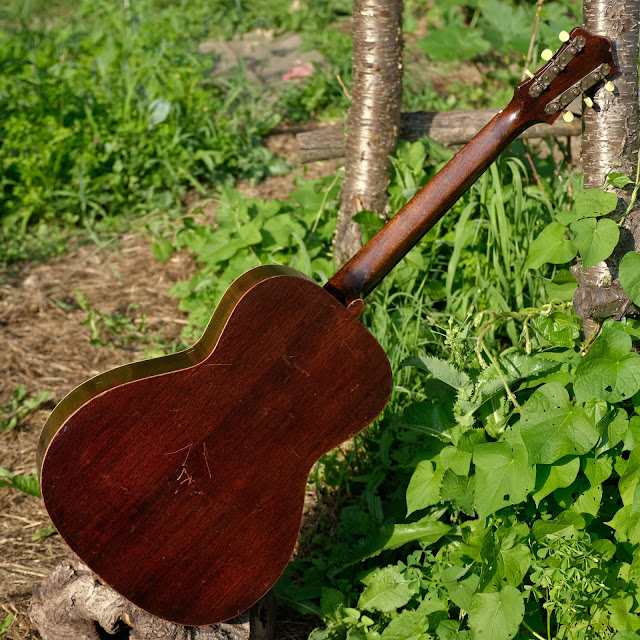1938 Gibson-made Recording King Carson Robison Model K Flattop Guitar
While the headstock on this guitar boldly proclaims this a Recording King Model K, it's actually just a rebranded Kalamazoo KG-14 as-sold by Montgomery Wards. As usual for this model, it's a guitar almost tailor-made for fingerpickers that need to be heard in a band setting. It's ladder-braced, loud, punchy, dry, and forward. As a flatpicker, I never quite get used to these instruments except as lead/fill or zip-zap gypsy-like guitars, but once you put the fingerpicks on and dig-in they do it! That said, if you've got a lighter touch, you can pull out a lot of good flatpicking sounds from these, too. I tend to dig pretty hard.
Work included a neck reset, fret level/dress, new bridge install, cleats to two top cracks, a popsicle brace install under the fretboard extension, new bone nut and saddle, new ebony pins all around, and a good setup. It came to me with no bridge and a fair bit of finish muck-up all around the bridge area -- hence why I installed a slightly oversized, belly-style bridge instead of a more-normal "straight" bridge. It's playing on-the-dot and has a straight neck. The fretboard extension over the body noticeably dips despite my shimming it up a bit, though up to the 15th/16th fret it feels normal.
Specs are: 24 13/16" scale, 1 3/4" nut, 1 1/2" string spacing at the nut, 2 1/8" spacing at the bridge, 14 3/4" lower bout, 10 1/8" upper bout, and 4 3/8" side depth at the endblock. The neck profile is medium-to-large V-shape and the board's radius is somewhere around ~10" or so. Action is 3/32" EA and 1/16" DGBE at the 12th fret and it's strung with 52w, 38w, 28w, 20w, 15, 11 gauges -- the heaviest I'd put on for standard E-to-E tuning. The saddle has plenty of height for adjustments up/down.
Woods are: solid spruce top, solid mahogany back, sides, and neck, rosewood fretboard, and (new) rosewood bridge. The bridge pins and endpin are ebony and the nut and saddle are bone. It's all-original save for bridge, pins, nut, and saddle.
Towards the later '30s, the Kalamazoo-style Gibson guitars get wider and more vibrant sunbursts.
The frets are the usual, thin, little Gibson wire from the time.
Please don't crucify me for the non-original bridge shape. This guitar came with a tailpiece on it and a plastic, adjustable bridge floating over a scratched-up bridge area. I'm imagining someone reglued the original several times and so the footprint expanded. This belly-bridge has a sanded-down rear so it's not as bulky as a full-size one.
As you can see, there's a ton of saddle height. As usual for this type of guitar, the top does "belly" around the bridge -- but it's stable.
As far as wear-and-tear goes, there's a lot of use-wear on the guitar including roughed-up areas, scratches, nicks, and dings.
As far as cracks, there's one longer cleated/sealed one from the bridge to the endblock on the top. There's also a short, 1/2" repaired one to the rear of the bridge's treble wing. The center seam ahead of the bridge was also open and is now cleated and sealed, too.
The original Kluson tuners work just fine.
It comes with its original, Geib chip case. I've reinforced/patched a few torn areas on the lid (at the hinges, mostly) with black duct-tape.






















Comments